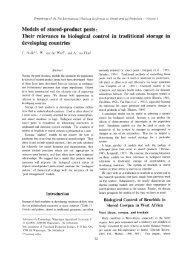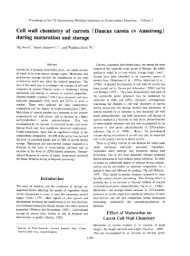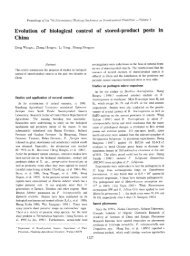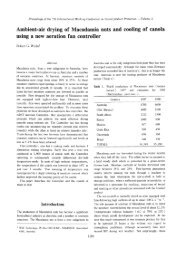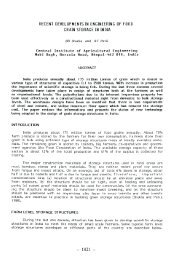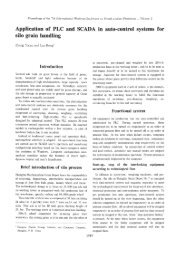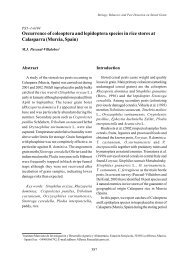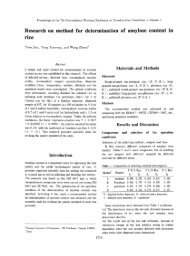Coping strategies employed by farmers against the larger grain ...
Coping strategies employed by farmers against the larger grain ...
Coping strategies employed by farmers against the larger grain ...
Create successful ePaper yourself
Turn your PDF publications into a flip-book with our unique Google optimized e-Paper software.
Proceedings of <strong>the</strong> 7 th International Working Conference on Stored-product Protection. - Yohcme 2<br />
harvest that <strong>farmers</strong> have maize in storage on farm. Looking<br />
across all regions, Figure 7b shows that <strong>farmers</strong> exhaust<br />
stocks of maize between 8 and 10 months after harvest in a<br />
non-drought year. In a drought year this reduces to between<br />
5 and 6 months.<br />
<<br />
10~"k r-<br />
90% I<br />
eos, r<br />
E<br />
'" 00<br />
10% i<br />
50%<br />
;0% I<br />
40%<br />
~ ;0%<br />
t: " :20% I I<br />
"'ill<br />
0% ,<br />
~<br />
<<br />
~~<br />
Fig. 6.<br />
35%<br />
30%<br />
Ul 25%<br />
(ij<br />
E<br />
~ 20%<br />
a<br />
ill<br />
Ol<br />
rn<br />
C<br />
ill<br />
0<br />
(ij<br />
CL<br />
15%<br />
10%<br />
-~~~I--I<br />
, I<br />
I I<br />
~ ~ l "<br />
:r , ~ ~<br />
~ I<br />
Reasons for changes in <strong>the</strong> varieties of maize<br />
cultivated at present compared with 15 years ago.<br />
5% .<br />
U.~l l<br />
12 ,-----------_---j Normal years<br />
10 Drought years!<br />
Figure 8 shows that at least 50% of <strong>farmers</strong> stated that<br />
<strong>the</strong>re had been no change in <strong>the</strong> duration of maize storage in<br />
comparison with 15 years ago. In Arusha and Iringa , 80 %<br />
of <strong>farmers</strong> stated 'no change' , in Kilimanjaro , 65 %,and in<br />
Morogoro, Rukwa and Tabora around 50 %. In Morogoro<br />
and Rukwa, 30 - 40% of <strong>farmers</strong> stated that <strong>the</strong>re had been<br />
a decrease due to non- LGB reasons (most commonly a<br />
reduction in production). It was only really in Tabora and<br />
Kilimanjaro that a significant minority of <strong>farmers</strong> attempted<br />
to avoid <strong>the</strong> effects of P. truneatvs <strong>by</strong> reducing storage<br />
and so curtailing <strong>the</strong> potential period of exposure of maize to<br />
<strong>the</strong> pest: 25% of <strong>farmers</strong> in Tabora and 15% of <strong>farmers</strong> in<br />
Kilimanjaro had taken such action. Unsurprisingly, in <strong>the</strong>se<br />
two regions also some <strong>farmers</strong> had increased <strong>the</strong> quantity of<br />
maize sold due to P. truncatus, (Figure 9). Lower<br />
percentages of <strong>farmers</strong> in o<strong>the</strong>r regions had also taken this<br />
action (less than 10% in o<strong>the</strong>r regions).<br />
~<br />
n~i<br />
Normal years<br />
o Drought years<br />
0% - .J1 -,._.-.....,_.-=-_.,--_ ....---r-.- ____ IJ<br />
0 2 3 4 5 6 7 8 9 10 11 12 13 14 15 16 17 18 22 24 34 36<br />
Duration of storage (months)<br />
Fig.7a. Duration of maize storage: aggregate for <strong>the</strong> 6 regions.<br />
o<br />
Fig.7b.<br />
Arusha<br />
Iringa Kilimanjaro Morogoro Rukwa Tabora<br />
Average duration of storage (with SEM) <strong>by</strong> regions.<br />
1777<br />
Summary<br />
In all <strong>the</strong> villages surveyed, P. truncatus has had no<br />
real impact on maize production outcomes at farm level.<br />
Impact on storage and marketing outcomes has been more<br />
evident, but even here behavioural change has been<br />
restricted to a minority of <strong>farmers</strong> in two regions, Tabora<br />
and Kilimanjaro. Taking all regions toge<strong>the</strong>r, <strong>the</strong>n,<br />
hypo<strong>the</strong>ses (a), (b) and (c) are unsuppcrted <strong>by</strong> <strong>the</strong> survey<br />
evidence. This poses <strong>the</strong> question: do <strong>farmers</strong> actually<br />
regard <strong>the</strong> pest as a major problem, and if so, are <strong>the</strong>y able<br />
to deal with if I (hypo<strong>the</strong>sis (d».<br />
I<br />
I<br />
-·1




